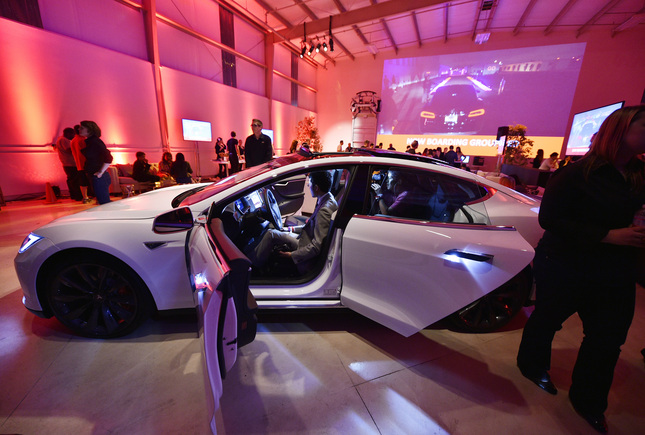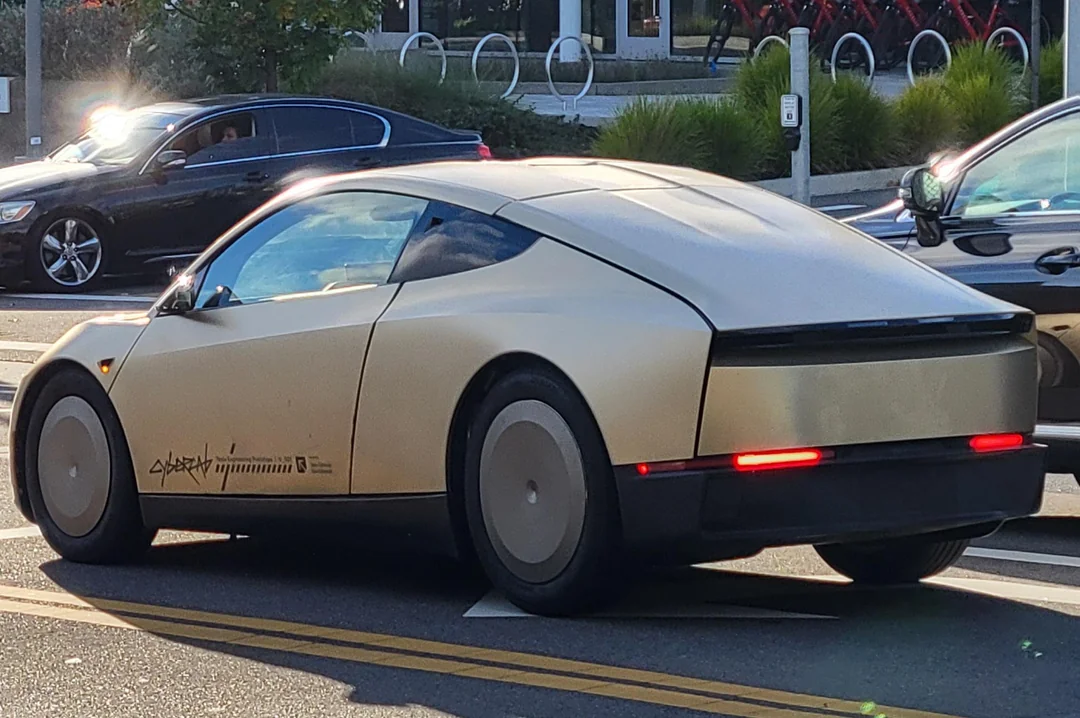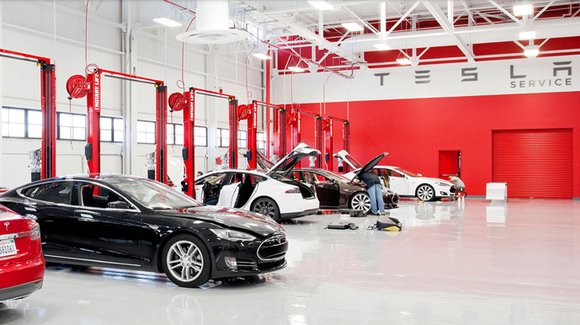News
How Tesla Challenges Other Car Makers
Tesla challenges other car makers to build better cars says Diarmuid O’Connell, Telsa’s vice president of business development at an industry conference.

Diarmuid O’Connell, Tesla’s VP of business development, had harsh words for competitors last week at the CAR management briefing seminars in Michigan. He told the group that Tesla challenges other car makers to build better cars.
“You can split the market of EVs into two programs,” he said. “Many are compliance programs. Exceptions are Nissan, ourselves and BMW. Most are focused on minimum compliance, lowest common denominator behavior, and the vehicles reflect that. In some respect, they are appliances, in terms of the way they look.”
CARB And The EPA
His remarks come at a time when two important regulatory programs are up for review. The California Air Resources Board is taking a look at its zero emissions vehicle policies and the Environmental Protection Agency is considering changes to its CAFE standards.
Traditional car makers are trying to get both agencies to relax those standards, but O’Connell says they should stop trying to “slow walk” the rate of progress toward a emissions free future and get busy building better cars. He says his company wants California and the EPA to raise their standards, not relax them.
“From an empirical standpoint, the [regulations] are very weak, eminently achievable and the only thing missing is the will to put compelling products on the road,” he said, according to The Wall Street Journal.
This week, Mary Nichols, CARB chairwoman since 2007, announced that she isn’t satisfied with having just a few electric cars on California roads. The current standard calls for 2.7% of all cars sold in California to be electric. Nichols wants to set the bar higher. In fact, she would like it if all the cars sold in California were electric by 2030.
For its part, the automotive industry is busy telling the EPA that the current CAFE standards are too high. Any further tightening would be bad for business. “We need consumers to buy them in high volumes to meet the steep climb in fuel economy standards ahead,” the Alliance of Automobile Manufacturers, an industry lobbying group, told the conference. The implication is that higher standards will kill the automotive business, cause massive layoffs, and have a negative impact on the economy.
This is precisely the same argument the automobile industry made about safety related changes in the ’50’s, seat belts in the 60’s, exhaust emission in the 70’s, airbags in the 90’s and better crash test performance at the beginning of the 21st century. Its complaints today are just more of the same.
CAFE Olay
The furor over EPA standards is actually a tempest in a teapot. On the surface of it, the 54.5 mpg requirement by 2025 seems like a huge increase above present day performance. But in reality, that standard is based on the old EPA mileage testing protocol, which was amended several years ago because it resulted in numbers that were wildly optimistic.
When the EPA adopted a new standard designed to better reflect real world expectations, it did not apply the new standard to the computation of the 2025 goal. If it did, that 54.5 mpg number would convert to around 37 mpg — which many of today’s cars are already capable of achieving.
To suggest that car companies cannot achieve a CAFE of 37 mpg using the current EPA protocol is patently absurd. In fact, a representative of Johnson Controls, one of the largest suppliers of components to the automobile manufacturing , said last year that car makers can easily meet the new standard and, in fact, many are already doing so today with internal combustion cars.
Charging Technology
One area where other manufacturers need to step up involves recharging technology for EVs and plug-in cars. At present, the best any of those other cars can handle is 50 kW. Tesla already has Superchargers with more than double that capacity. It’s new liquid cooled charging cables indicate the company has even higher power chargers in mind for the future.
O’Connell told the conference that drivers of competitors’ cars would be welcome to use the Supercharger network if only their cars were capable of handling the higher current. Tesla made its Supercharger patents public last year, but no other manufacturer has expressed any interest in them. Instead, the industry seems content to live with 50 kW “fast chargers” that really aren’t all that fast.
The Week In Review
Tesla has had a rough week. The stock market was disappointed with what Elon Musk had to say during the 2nd quarter conference call and punished the company’s stock, which closed down nearly 9% for the week.
The real question on people’s minds is whether Tesla will bring electric cars to the masses the way the Model T put the world on wheels almost a century ago, or whether it is a company that caters only to the wealthy and will flame out the way the Concorde SST did? If you are reading this, chances are we know how you would answer that question.

News
Tesla Model 3 named New Zealand’s best passenger car of 2025
Tesla flipped the switch on Full Self-Driving (Supervised) in September, turning every Model 3 and Model Y into New Zealand’s most advanced production car overnight.

The refreshed Tesla Model 3 has won the DRIVEN Car Guide AA Insurance NZ Car of the Year 2025 award in the Passenger Car category, beating all traditional and electric rivals.
Judges praised the all-electric sedan’s driving dynamics, value-packed EV tech, and the game-changing addition of Full Self-Driving (Supervised) that went live in New Zealand this September.
Why the Model 3 clinched the crown
DRIVEN admitted they were late to the “Highland” party because the updated sedan arrived in New Zealand as a 2024 model, just before the new Model Y stole the headlines. Yet two things forced a re-evaluation this year.
First, experiencing the new Model Y reminded testers how many big upgrades originated in the Model 3, such as the smoother ride, quieter cabin, ventilated seats, rear touchscreen, and stalk-less minimalist interior. Second, and far more importantly, Tesla flipped the switch on Full Self-Driving (Supervised) in September, turning every Model 3 and Model Y into New Zealand’s most advanced production car overnight.
FSD changes everything for Kiwi buyers
The publication called the entry-level rear-wheel-drive version “good to drive and represents a lot of EV technology for the money,” but highlighted that FSD elevates it into another league. “Make no mistake, despite the ‘Supervised’ bit in the name that requires you to remain ready to take control, it’s autonomous and very capable in some surprisingly tricky scenarios,” the review stated.
At NZ$11,400, FSD is far from cheap, but Tesla also offers FSD (Supervised) on a $159 monthly subscription, making the tech accessible without the full upfront investment. That’s a game-changer, as it allows users to access the company’s most advanced system without forking over a huge amount of money.
News
Tesla starts rolling out FSD V14.2.1 to AI4 vehicles including Cybertruck
FSD V14.2.1 was released just about a week after the initial FSD V14.2 update was rolled out.

It appears that the Tesla AI team burned the midnight oil, allowing them to release FSD V14.2.1 on Thanksgiving. The update has been reported by Tesla owners with AI4 vehicles, as well as Cybertruck owners.
For the Tesla AI team, at least, it appears that work really does not stop.
FSD V14.2.1
Initial posts about FSD V14.2.1 were shared by Tesla owners on social media platform X. As per the Tesla owners, V14.2.1 appears to be a point update that’s designed to polish the features and capacities that have been available in FSD V14. A look at the release notes for FSD V14.2.1, however, shows that an extra line has been added.
“Camera visibility can lead to increased attention monitoring sensitivity.”
Whether this could lead to more drivers being alerted to pay attention to the roads more remains to be seen. This would likely become evident as soon as the first batch of videos from Tesla owners who received V14.21 start sharing their first drive impressions of the update. Despite the update being released on Thanksgiving, it would not be surprising if first impressions videos of FSD V14.2.1 are shared today, just the same.
Rapid FSD releases
What is rather interesting and impressive is the fact that FSD V14.2.1 was released just about a week after the initial FSD V14.2 update was rolled out. This bodes well for Tesla’s FSD users, especially since CEO Elon Musk has stated in the past that the V14.2 series will be for “widespread use.”
FSD V14 has so far received numerous positive reviews from Tesla owners, with numerous drivers noting that the system now drives better than most human drivers because it is cautious, confident, and considerate at the same time. The only question now, really, is if the V14.2 series does make it to the company’s wide FSD fleet, which is still populated by numerous HW3 vehicles.
News
Waymo rider data hints that Tesla’s Cybercab strategy might be the smartest, after all
These observations all but validate Tesla’s controversial two-seat Cybercab strategy, which has caught a lot of criticism since it was unveiled last year.

Toyota Connected Europe designer Karim Dia Toubajie has highlighted a particular trend that became evident in Waymo’s Q3 2025 occupancy stats. As it turned out, 90% of the trips taken by the driverless taxis carried two or fewer passengers.
These observations all but validate Tesla’s controversial two-seat Cybercab strategy, which has caught a lot of criticism since it was unveiled last year.
Toyota designer observes a trend
Karim Dia Toubajie, Lead Product Designer (Sustainable Mobility) at Toyota Connected Europe, analyzed Waymo’s latest California Public Utilities Commission filings and posted the results on LinkedIn this week.
“90% of robotaxi trips have 2 or less passengers, so why are we using 5-seater vehicles?” Toubajie asked. He continued: “90% of trips have 2 or less people, 75% of trips have 1 or less people.” He accompanied his comments with a graphic showing Waymo’s occupancy rates, which showed 71% of trips having one passenger, 15% of trips having two passengers, 6% of trips having three passengers, 5% of trips having zero passengers, and only 3% of trips having four passengers.
The data excludes operational trips like depot runs or charging, though Toubajie pointed out that most of the time, Waymo’s massive self-driving taxis are really just transporting 1 or 2 people, at times even no passengers at all. “This means that most of the time, the vehicle being used significantly outweighs the needs of the trip,” the Toyota designer wrote in his post.
Cybercab suddenly looks perfectly sized
Toubajie gave a nod to Tesla’s approach. “The Tesla Cybercab announced in 2024, is a 2-seater robotaxi with a 50kWh battery but I still believe this is on the larger side of what’s required for most trips,” he wrote.
With Waymo’s own numbers now proving 90% of demand fits two seats or fewer, the wheel-less, lidar-free Cybercab now looks like the smartest play in the room. The Cybercab is designed to be easy to produce, with CEO Elon Musk commenting that its product line would resemble a consumer electronics factory more than an automotive plant. This means that the Cybercab could saturate the roads quickly once it is deployed.
While the Cybercab will likely take the lion’s share of Tesla’s ride-hailing passengers, the Model 3 sedan and Model Y crossover would be perfect for the remaining 9% of riders who require larger vehicles. This should be easy to implement for Tesla, as the Model Y and Model 3 are both mass-market vehicles.










